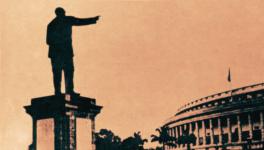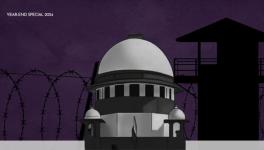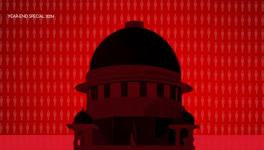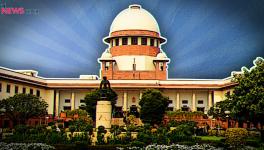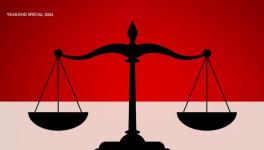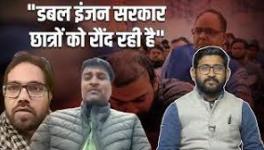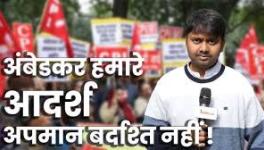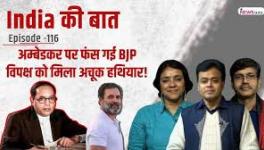DY Chandrachud: The New Right Liberal
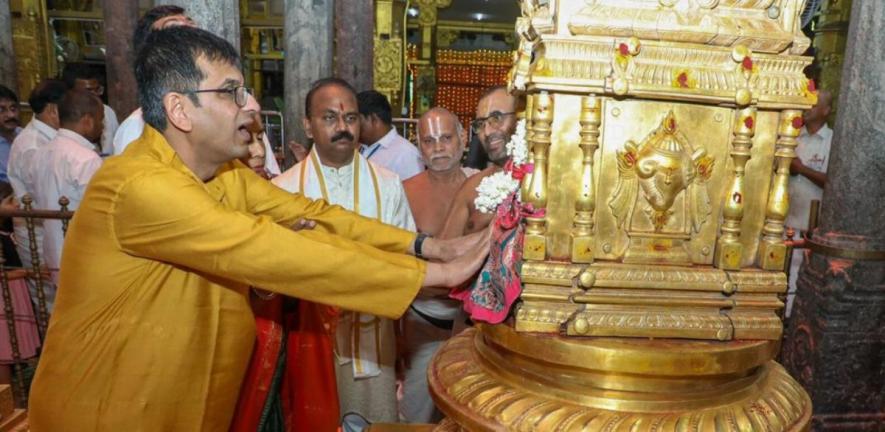
Outgoing CJI DY Chandrachud. Image Credit: The Leaflet
Much has been written and said about the outgoing Chief Justice of India Dr D.Y. Chandrachud, yet he remains a mysterious character combining under one skin his Hindu right-wing ideology with his liberal defence of the rights of individuals as enshrined in the Constitution of India, something we have not seen before.
But let us begin at the beginning. He was destiny’s child, his late father, himself a Chief Justice of India— and the longest-serving in independent India at that— ensured that he would one day become the Chief Justice of India by ensuring he was appointed a judge at a young age.
After being the Chief Justice of the Allahabad High Court, one of the largest in the country, he was appointed as a judge of the Supreme Court on May 13, 2016. A right-wing Hindu party had firmly established itself in power by then.
He was at the cusp of history, where he could have stopped the onward march of the Hindutva juggernaut and the violence they were committing on the streets of the county not only against minorities but also against human rights defenders from the majority community.
The office of the Chief Justice of India is one of the most powerful in the country. The power of judicial review bequeathed by the Constitution to the judiciary enables judges to sit in judgment over those who hold elected executive office. It is also an office that embodies for the nation the very idea of justice.
Exercising this power correctly requires a commitment to the values of the Constitution, which is expected from every judge who takes an oath of allegiance to the Constitution as by law established. It is this power that Justice Chandrachud consciously abandoned when it was much needed.
As a judge of the Supreme Court
He served on the Supreme Court of India under seven Chief Justices of India, Justice T.S. Thakur, Justice J.S. Khehar, Justice Dipak Misra, Justice Ranjan Gogoi, Justice S.A. Bobde, Justice N.V. Ramana and Justice U.U. Lalit. Disappointment over the functioning of some of the previous Chief Justices of India was already publicly expressed before his appointment.
Every law was being weaponised against the weak. Criminal laws cast the victim as the aggressor by filing first information reports (FIRs) selectively against political opponents while taking no action against State actors who were responsible for hate speech and encouraging violence against minorities. A de facto Hindu State was being established.
Justice Chandrachud came to the Supreme Court in this atmosphere, destined to be a Chief Justice of India. He had had a modern education and exposure to world jurisprudence and international human rights law. His demeanour in the court was polite, courteous and calm, which won him praise and much support in the profession. He was not only modern in his training but also civilised in his behaviour.
Hopes that he would be able to establish ethical values for the conduct of judges and use the power of judicial review to prevent abuse of executive power did not seem misplaced at all.
The enthusiasm and expectations of the many human rights constituencies were met by his performance. In 2017, he delivered the Puttaswamy judgment, where he not only held the right to privacy to be a fundamental right but also formally overruled his father’s judgment in the ADM Jabalpur case, which had held that the right to life and liberty could be suspended during an Emergency.
I recall writing an editorial in the Indian Express appreciating this act of honesty by the Supreme Court, belated though it may have been. He gave a dissent in the Aadhar case, holding that no law compelling the obtaining of an Aadhar card could be passed as a money Bill.
In Navtej Johar, decided on September 6, 2018, ignoring a pending curative petition challenging the Kaushal judgment, a Bench of five judges, of which he was a part, decriminalised Section 377 of the Indian Penal Code.
His best innings in the Supreme Court of India came when he sat with Chief Justice of India Dipak Misra. It was sitting with him that he delivered the judgment in the Shafin Jahan case on April 9, 2018, where he held that a Hindu woman had the right to convert to Islam and marry the man of her choice; the live streaming judgment on September 26, 2018, which changed the face of the Supreme Court of India and made it people friendly; and the Sabarimala judgment on September 28, 2018, where he held that Hindu women of all ages had the right to enter the Sabarimala temple to worship.
Hopes that he would be able to establish ethical values for the conduct of judges and use the power of judicial review to prevent abuse of executive power did not seem misplaced at all.
He also delivered a dissent in the Romila Thapar case on September 28, 2018, where he held, contrary to the majority, that the arrest of activists in the Bhima Koregaon case called for an inquiry into the criminalisation of dissent.
All this and more built for him the image of the much-awaited liberal judge who delivered on the promise of protection of human rights.
But on this journey, he also delivered the judgment in the Tehseen Poonawalla case on April 19, 2018, in which the petitioner had called for an enquiry into the unnatural death of Judge Loya.
It was then that it should have become clear that Justice Chandrachud was unwilling to hold power to account. An investigation into the death of a judge who was hearing a case in which the current home minister of the country was implicated as an accused in a murder trial would have meant casting a cloud over the accused, preventing him from holding public office.
An investigation was undoubtedly required into the unnatural death of a judge in Nagpur who once heard the case. The cause for concern was that the postmortem of the judge’s corpse was conducted without informing his wife, as required by the law. The wife was in Mumbai, which would have meant a journey of less than two hours.
This stain was covered by his subsequent liberal judgments, restoring in the minds of the general public the image of a clean, liberal and erudite judge.
Justice Gogoi became the Chief Justice of India on October 3, 2018. He constituted the Ayodhya Bench of four other potential Chief Justices of India (Justice Ramana wisely recused himself from the case) of which Justice Chandrachud (as he was then) was a member. When the judgment was passed, its author remained anonymous.
We now know that Justice Chandrachud authored the judgment (being divinely inspired). After the Ayodhya judgment, few had any illusions left about his judicial philosophy or lack of it. He had lost the battle to turn the tide of history back to secularism as a founding faith of the Constitution.
As the Chief Justice of India
Justice Chandrachud became the Chief Justice of India on November 9, 2022, less than two years away from general elections due in May–June 2024. With this, he became the ‘master of the roster’, with the power to decide which cases would be heard by which Benches.
Most cases relating to the incarceration of human rights defenders under the Unlawful Activities (Prevention) Act (UAPA), 1967 found their way to Benches presided over by Justice M.R. Shah who, while he was a high court judge, had referred to Prime Minister Narendra Modi as a “hero” and “model”.
Chief Justice U.U. Lalit had also on a Saturday constituted a Bench to hear an appeal against the acquittal of the late Prof. G.N. Saibaba, presided over by Justice Shah.
When the counsel for Prof. Saibaba argued that he could hardly be a terrorist, being 90 percent disabled, the judge responded by saying that terrorism did not come from the barrel of the gun but from the mind. He stayed the post-acquittal release of Prof. Saibaba.
A Bench headed by Justice Shah then reversed a long-standing judgment of Justice Markandey Katju to the effect that there can be no guilt by association, thereby criminalising a whole constituency of citizens who have committed no criminal act.
Many cases relating to life and liberty also found their way to a Bench with Justice Bela Trivedi on it. Justice Trivedi was the law secretary to the Modi government when he was the chief minister of Gujarat.
It was during this period that pre-trial jail and not bail became the norm of the Supreme Court of India. The accused in the Bhima Koregaon case, granted bail by the Bombay High Court, had their bail Orders stayed by the Supreme Court of India by a Bench of which Justice Trivedi was a member. Many withdrew their petitions for bail rather than have them dismissed by the Supreme Court.
This attitude spread among the judiciary. Under the watch of Chief Justice of India Chandrachud, the country saw judges of various high courts and the Supreme Court delay bail hearings and deny bail to human rights defenders.
Chief ministers arrested under the Prevention of Money Laundering Act (PMLA), 2002 were denied bail with no shred of evidence of a money trail. Under Chief Justice of India Chandrachud’s watch, Umar Khalid has been denied bail for over four years.
And these are among the more privileged of the incarcerated. If they can be denied bail, what is the hope for the thousands of others, many of whom do not even have proper legal representation, and who have been reduced to a nameless and faceless mass of undertrials?
In his role as the master of the roster and as the head of the Indian judiciary, he failed the test of protecting the rights of citizens under Article 21 of the Constitution of India.
And yet the illusion of his being a liberal continued. In a misplaced evaluation of his ability to do justice to the LGBTQI community, petitions were hurriedly filed in the Supreme Court of India to declare the rights of non-heterosexual couples to marry as a fundamental right.
A Bench presided over by the Chief Justice of India held that far from there being such a right, there was also no fundamental right to marry at all, it was no more than the statutory right.
On December 17, 2023, he presided over a Bench that upheld the abrogation of Article 370 of the Constitution of India through unlawful means.
One of the most devastating of his decisions, for which he alone must take responsibility, was the reopening of the Gyanvapi mosque case.
In his own judgment in the Ayodhya case, he had held that save and except for the Ayodhya dispute, no other cases of disputed religious sites could be reopened having regard to the Protection of Religious Places Act, 1991, which prohibited such reopening.
Despite this, on the frivolous ground that Hindus were not seeking a change of character of the Gyanvapi mosque but only to determine its religious character, Chief Justice of India Chandrachud permitted suits to go on. The domino effect of this decision and its consequences can well be imagined.
He took suo moto jurisdiction to a different level, taking cognisance of issues that had no foreseeable legal outcome but were political in nature. Both in Manipur and West Bengal, this was justified on the ground that the rape and murder of women had “shocked the conscience of the nation”, which they indeed did.
Those cases of rape and murder will find their way through the legal system as any other rape cases do. Apart from the criminal act of rape and murder, which have in both cases been handed over to the Central Bureau of Investigation (CBI) for investigation, and where chargesheets have been filed, there was no issue to adjudicate in a court of law.
However, the suo moto cognisance has the effect of pre-empting the political process, leaving political power unaccountable. The issue was always one of misuse of political power, which called for a political solution.
Peace was not restored to Manipur. Resident doctors in West Bengal have not had the threat culture they face addressed. However, the Supreme Court ensured that agitation for the demand for the safety and security of doctors was withdrawn.
He took suo moto cognisance of the shifting of the High Court of Bombay from South Bombay to the suburbs, though the matter was pending in the Bombay High Court, ensuring that the foundation stone was laid during his tenure as the Chief Justice of India knowing fully well that no court would come up in the foreseeable future. The task of the post-Chief Justice of India Chandrachud court will be to narrow down rather than expand the scope of suo moto cognisance to avoid judge-driven jurisdiction.
Public interest litigation (PILs) at the instance of lawyers found favour with the Chief Justice of India Chandrachud-led court on several significant issues. During Covid-19, he took cognisance of issues that arose from the lockdown at the instance of lawyers, finally endorsing the strategy of the National Disaster Management Authority.
One of the critical issues was the availability of vaccines, with the pharma industry demanding patents and jacking up the prices. A direction was sought to the government to exercise its power of granting compulsory licences (an exception that allows a third party to make, use, or sell a patented product or process without the consent of the patent owner) but Justice Chandrachud sat over the matter.
Similarly, at the instance of lawyers who were petitioners, the Chief Justice of India took cognisance of the Hindenburg investigation into the Adani empire, which resulted in removing it from other legitimate investigative forums, including the political process.
As a speaker
In the final analysis, it is his extra-judicial speeches and behaviour that explain the mystery that is Chief Justice of India Chandrachud.
Looking back, we know that for him, the dhwaja (flag) that sat atop temples was the flag of justice, not the tricolour flag, which represents the idea of India. We also know that he invited Prime Minister Modi to his residence for a puja on Ganesh Chaturthi, ignoring all his brother and sister judges. His white marble lady of justice is a savarna woman. He appointed seventeen judges to the Supreme Court of India, not one is a woman. He leaves a court on which one-third of all judges are Brahmins.
In seeking guidance from the divine to resolve a legal issue, he abandoned the source of sovereignty that emanates from ‘We the People of India’ and found it in divinity.
Perhaps it is here we see the merging of his two parts— the liberal and the divinely driven— the emergence of a New Right, one that is modern and yet able to rely on a norm above the Constitution to perform the judicial function.
This could only happen in the absence of a moral compass. At the very top, where there is no higher authority to which one is answerable, one is only guided by one’s moral compass. For a Chief Justice of India, the compass must always point towards the Constitution of India. Power without constitutional morality tracing itself to the sovereignty of the people is unhinged, unaccountable power.
Only time will tell whether severe damage has been done to the concept of separation of powers between the executive and the judiciary and whether the power of judicial review over executive action, which has stayed dormant for ten years, will be revived in the days to come.
Only an appeal to reason, law and evidence can restore the status of the Chief Justice of India to its rightful place under the Constitution and not above the Constitution.
At a felicitation at the High Court of Bombay, he concluded his speech indicating that his retirement was not the end of an innings but only the beginning. “You will hear from me formally and informally,” he said.
I have said it before and I will say it again: judges must be judged by their post-retirement conduct. I have an uncanny feeling that the outgoing Chief Justice of India will not retire from power.
Courtesy: The Leaflet
Indira Jaising is a noted human rights lawyer and a senior advocate at the Supreme Court of India. She is also a co-founder of The Leaflet.
Get the latest reports & analysis with people's perspective on Protests, movements & deep analytical videos, discussions of the current affairs in your Telegram app. Subscribe to NewsClick's Telegram channel & get Real-Time updates on stories, as they get published on our website.










